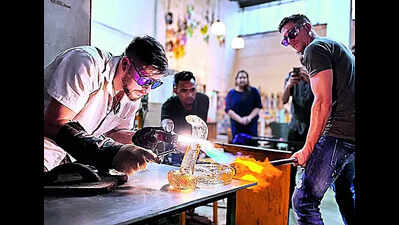How Mumbai’s only blown glass art studio breaks the mould | Mumbai News – Times of India


Garam karo. Phoonk maro. Thandi. Hawa. Theek hai. Acha.” Clearly, Matthew Piepenbrok doesn’t need the white board meant for artists in residency anymore. The American-who is sipping water from a coloured glass with an uneven rim-has spent most of the last three years inside this first-floor former cloth mill in Govandi bonding withAjay Kumar, a cheerful veteran glassblower from Agra’s Firozabad and Rohan Gangurde, a distressed-jeans-sporting 25-year-old from Chembur’s Siddharth Nagar.Heating, reheating, melting, cooling, casting, cutting and tweezing hot glass into art with them means the whiteboard bearing Hindi translations for words like ‘open’ and ‘close’ is redundant for the American who knows what ‘jugaad’ means. This afternoon, as Ajay hands him an apple, the seasoned American glass artist watches Rohan stick a long thin metal pipe into a glass-melting furnace with the casual swagger of a woodfired pizza baker. “He could soon become one of Maharashtra’s first glassblowers,” says Piepenbork about the former office boy who used to clean jugs and glasses till he started making them for a living.
Moulding a new generation of Indian blown glass artists is among the crystal-clear goals of Rural Modern Glass Studio, Mumbai’s and likely India’s only blown glass studio that-like its counterparts in America-keeps its door open. “There is severe gate-keeping in the rest of India,” says Piepenbork, a product of the American Studio Glass Movement that transformed glass from a mass production tool into a medium of fine art in th 1960s. The wave of artists that emerged after one Harvey Littleton created a small-scale furnace that gave artists the ability to work hot glass individually in their setups, later shared their knowledge globally. “There are no secrets in glass in America,” says Piepenbork, who finds the nascent glass art industry in India, a mosaic of fragmented art studios in various cities, closed off. “They fear that their ideas will be stolen,” says Piepenbrok who finds a similar strain of opacity in Firozabad-India’s industrial glassmaking hub-as in Murano, Italy’s 500-year-old blown glass art epicentre, which “locks its secrets in vaults”.
“I always wanted to make glass art publicly accessible,” says Rural Modern’s co-founder Arjun Rathi, an architect who morphed into a lighting designer in 2012 after fashioning a car headlight into a lampshade for a friend. To fulfil the orders that followed, he would import material from Europe and China as the palette of shapes, colours and patterns available in Firozabad was small. “Glass used in mass production is very different from glass used in art, which tends to be much softer,” says Rathi.
When Covid put paid to importing, Rathi had a wall near the narrow doorway of a defunct cloth mill broken to make way for a glass-melting furnace, an annealer machine and a ‘Glory Hole’, as the reheating furnace is called. “I decided to open a glass art studio as I wanted to invite international artists to upskill our guys and produce glass art inspired by rural India,” says Rathi.
As various artists in residency–from California’s Brent Sheehan to Chicago-based Anjali Singh-glazed their creations, they left in their wake a flood of fragilities including paperweights, flowers, birds, vases, ashtrays, lion heads, elephant trunks studded with glass flowers and other artworks that would later render recent recruit Rukhsar a nervous housekeeper.
The first two years of the studio’s making were full of sounds of things breaking. “There were many learnings,” says Rathi, who-along with the first American guest Jeremiah Jacobs–realized, for instance, that if coloured glass and the clear glass were not compatible with each other, it shatters. “Glass art is one of the hardest to master,” says Rathi recalling a popular industry refrain: “For the first three years, only your mother will like what you make.”
As much chemistry as it is alchemy, the technique is said to date back to 1st century BC Syria when craftsmen produced vessels shaped as shells, grapes, and human heads by melting glass, gathering this fiery molasses-like mass on the end of a hollow pipe, blowing into it and rolling it on a smooth surface to create a shape. “If the end of the pipe isn’t hot, molten glass won’t stick to it,” says Rohan, who calls the thin metal pipe he is rolling in the furnace a ‘fanti’. While still soft, the glass can be manipulated by hand tools or cut with shears. Piepenbrok favours a pair of Japanese tweezers to shape his creations which include one stuffed with paan wrappers, cigarette butts and other ingredients of “Mumbai trash”.
No glass from the studio floor becomes part of Mumbai trash, though. “All waste glass goes to recycling factories,” says Piepenbrok, who has answered eager questions such as “How is glass made?” (quick answer: from sand), and “Do you get burnt?” from kids and adults alike at the workshops hosted by the studio. “Most visitors have never seen the process of glass blowing. It’s hypnotic to watch,” says Rathi, whose studio most recently demonstrated the art to enthusiasts at a session organised by Indian National Trust For Art And Cultural Heritage.
While gloves and goggles help newcomers overcome their nervousness, Piepenbork says he can gauge future glassblowers. “They tend to be people who turn to the fire rather than run away from it,” he says, looking at Rohan who does not find the fanti hot to the touch anymore. What burns him is the thickness of the glass he made recently. “I need to learn to make a finer cut,” says Rohan. Then he shouts “Where’s the heart?” searching the room for the breakable object he created with another breakable object.















